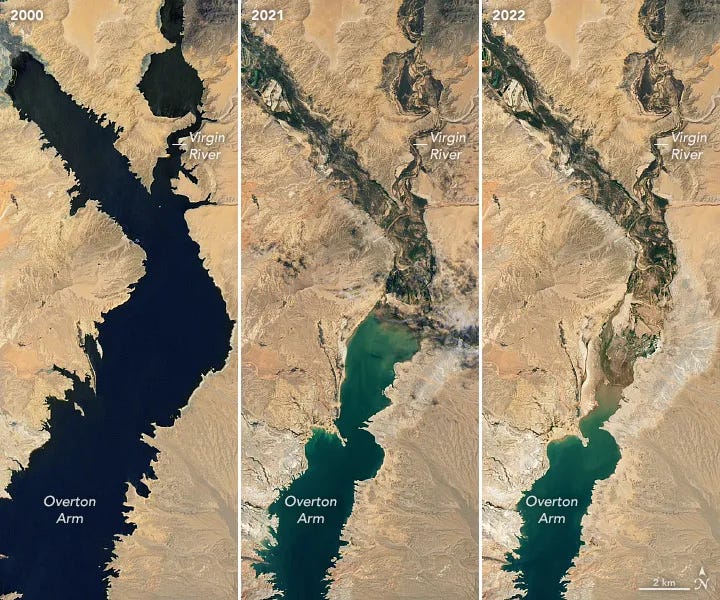Are water levels in Lake Mead evidence of climate change?
The Colorado River Compact and poor water management are primarily driving the drop in elevation, not climate change.
Source: https://www.usatoday.com/story/news/nation/2022/07/22/nasa-images-lake-mead-water-level-loss/10123279002/
What is the Colorado River Compact?
The Colorado River Compact is a legal agreement that was signed in 1922 among seven U.S. states that share the Colorado River Basin: Arizona, California, Colorado, Nevada, New Mexico, Utah, and Wyoming. The compact allocates the water rights of the Colorado River among these states, and it also established the framework for how the river's water is managed and used.
Under the compact, the upper basin states of Colorado, New Mexico, Utah, and Wyoming are required to deliver a certain amount of water annually to the lower basin states of Arizona, California, and Nevada. The agreement also established the United States Bureau of Reclamation to manage the river and its resources.
The compact has been amended several times over the years to address changes in water use and demands, but it remains a crucial document in the management of the Colorado River and its watersheds.
How has the water supply into the Colorado River Basin changed over time?
The water supply flowing into Lake Mead has changed over time due to various factors, including weather patterns, drought conditions, and water usage. Pre-1922: The Colorado River was largely unregulated, and there were no formal water allocation agreements among the seven basin states. With the signing of the Colorado River Compact in 1922, water allocations were established among the seven states. During the period from 1922-1970, water supplies were generally abundant, and Lake Mead was able to fill to near capacity. From 1970 through the 1990s there was a combination of increased water usage and drought conditions, resulting in a decline in the water supply flowing into Lake Mead. This led to a decrease in the lake's water levels, with several periods of drought causing the lake to drop to record-low levels. The 21st century has been marked by ongoing drought conditions, leading to continued declines in the water supply flowing into Lake Mead. As of 2021, Lake Mead is at historically low levels, with the reservoir hovering around 35-40% capacity.
Overall, the water supply flowing into Lake Mead has fluctuated over time due to a complex combination of factors, however, precipitation rates throughout the Colorado River basin show no trend with climate change as shown below.
Source: https://www.mdpi.com/2306-5338/2/3/112
How has the population changed in the 7 states in the Colorado River Compact?
The population of the seven states that share the Colorado River Basin has grown significantly since the signing of the Colorado River Compact in 1922. Here are some key population changes:
Keep reading with a 7-day free trial
Subscribe to Irrational Fear to keep reading this post and get 7 days of free access to the full post archives.





